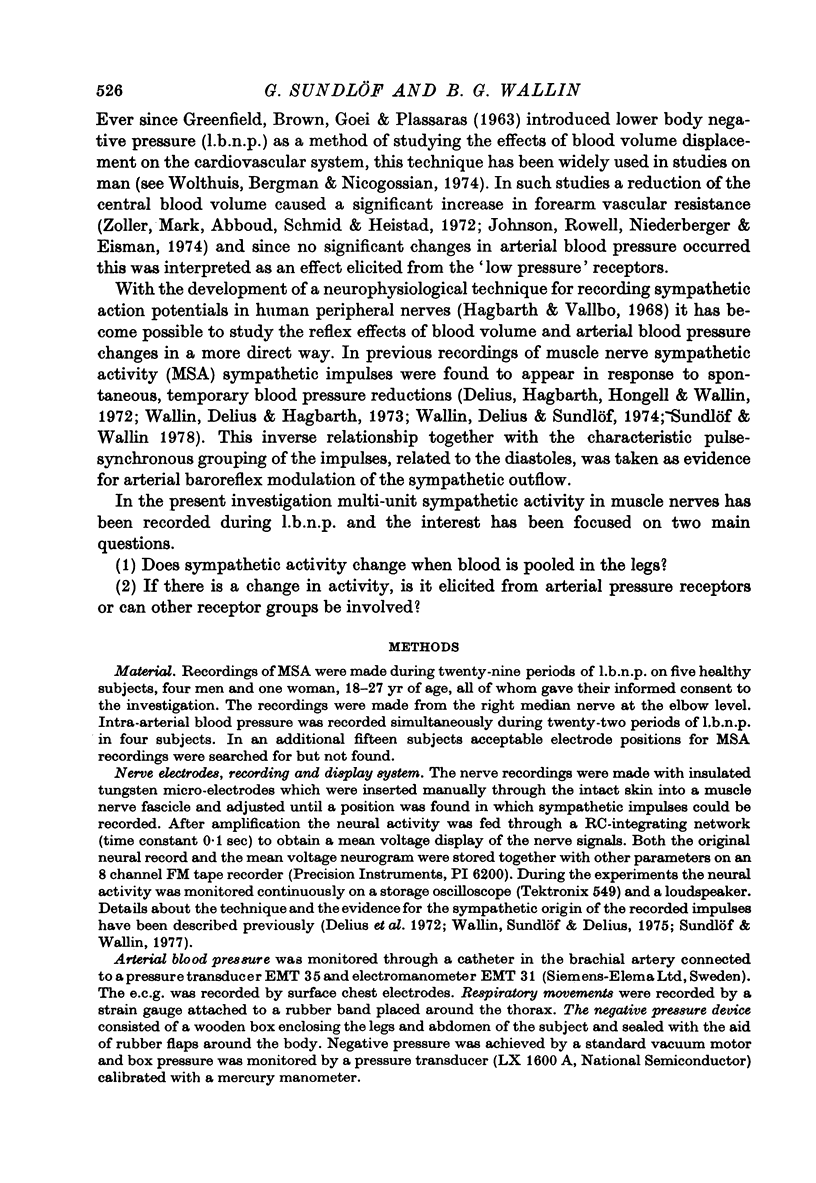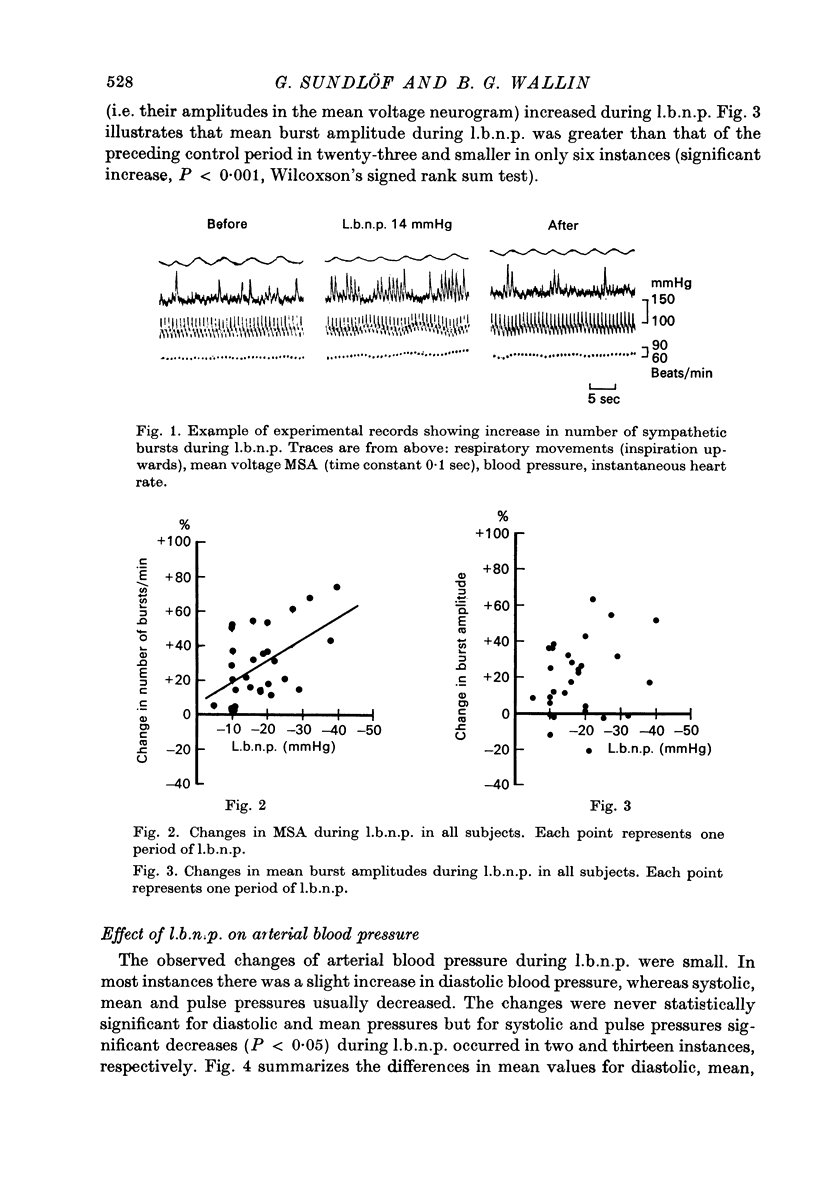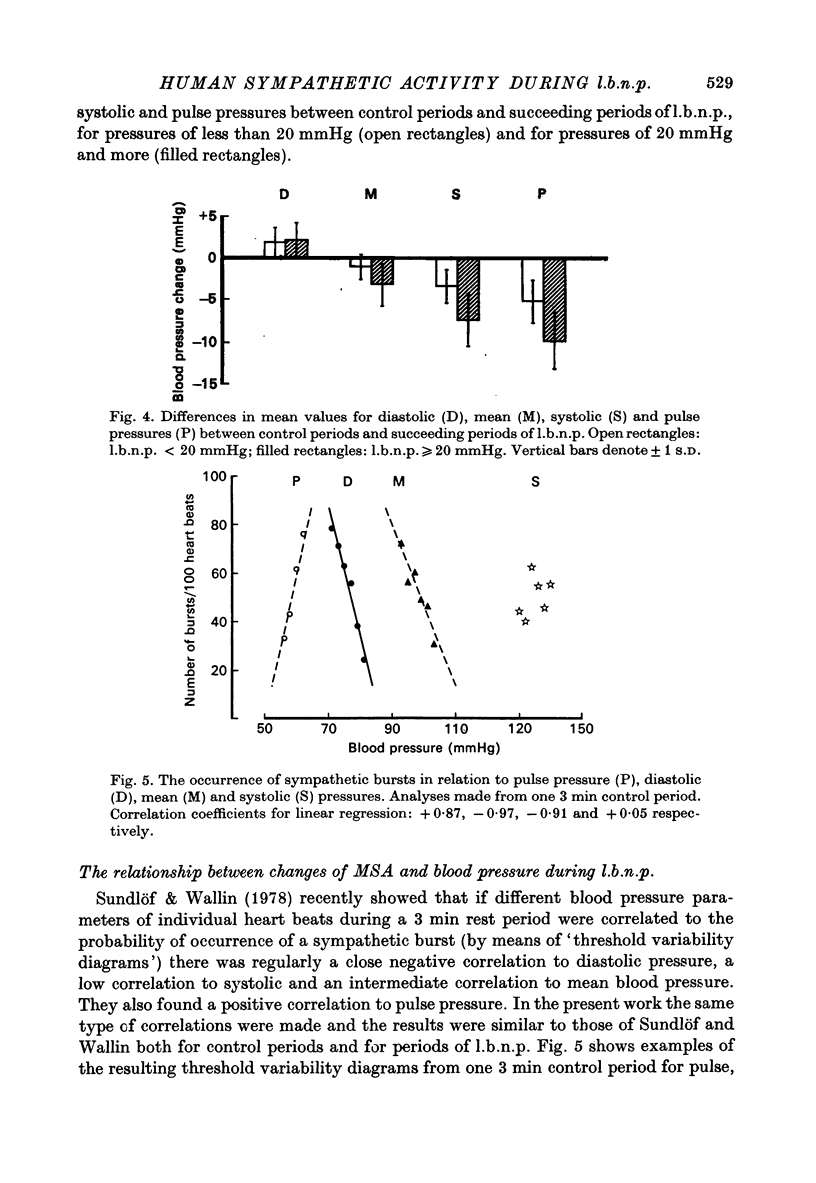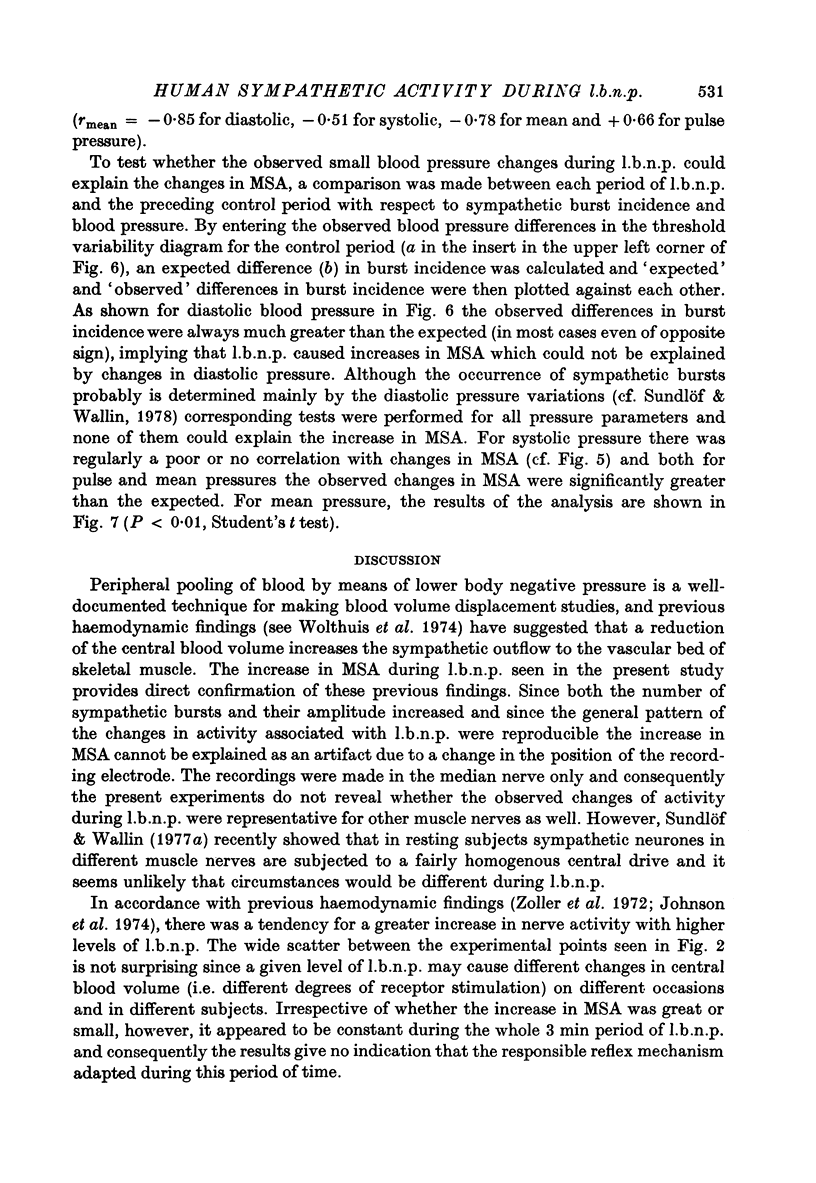Abstract
1. Recordings of multi-unit sympathetic activity were made from muscle branches of the median nerve in five healthy subjects during application of lower body negative pressure (l.b.n.p.). Simultaneous recordings of arterial blood pressure were made in four subjects. The strength of the neural activity was quantitated by counting the number of pulse synchronous sympathetic bursts and their amplitudes in the mean voltage neurogram.
2. The general appearance of the sympathetic activity in pulse synchronous bursts was similar during control periods and during l.b.n.p., but during l.b.n.p. there was always an increase in the number of sympathetic bursts and usually also in the mean voltage amplitude of the bursts.
3. The probability of occurrence of a burst was correlated to different blood pressure parameters of individual heart beats and both during control periods and during l.b.n.p. there was regularly a close negative correlation to diastolic, a low correlation to systolic, an intermediate negative correlation to mean and a positive correlation to pulse pressures.
4. The changes in arterial blood pressure during l.b.n.p. were small and in most cases statistically insignificant. The observed increases in the number of sympathetic bursts during l.b.n.p. were significantly greater than what could be expected on the basis of the blood pressure changes.
5. The findings suggest that the reflex control from the arterial baroreceptors is maintained during l.b.n.p. but, since the increase of sympathetic activity during l.b.n.p. could not be explained by a change in stimulation of the arterial baroreceptors, influence from other receptor groups (presumably intrathoracic volume receptors) must also have occurred.
Full text
PDF







Selected References
These references are in PubMed. This may not be the complete list of references from this article.
- Abboud F. M., Mark A. L., Heistad D. D., Eckberg D. L., Schimid P. G. Selectivity of autonomic control of the peripheral circulation in man. Trans Am Clin Climatol Assoc. 1975;86:184–197. [PMC free article] [PubMed] [Google Scholar]
- Bevegård S., Castenfors J., Lindblad L. E., Tranesjö J. Blood pressure and heart rate regulating capacity of the carotid sinus during changes in blood volume distribution in man. Acta Physiol Scand. 1977 Mar;99(3):300–312. doi: 10.1111/j.1748-1716.1977.tb10383.x. [DOI] [PubMed] [Google Scholar]
- Delius W., Hagbarth K. E., Hongell A., Wallin B. G. General characteristics of sympathetic activity in human muscle nerves. Acta Physiol Scand. 1972 Jan;84(1):65–81. doi: 10.1111/j.1748-1716.1972.tb05158.x. [DOI] [PubMed] [Google Scholar]
- Hagbarth K. E., Vallbo A. B. Pulse and respiratory grouping of sympathetic impulses in human muscle-nerves. Acta Physiol Scand. 1968 Sep-Oct;74(1):96–108. doi: 10.1111/j.1748-1716.1968.tb04218.x. [DOI] [PubMed] [Google Scholar]
- Johnson J. M., Rowell L. B., Niederberger M., Eisman M. M. Human splanchnic and forearm vasoconstrictor responses to reductions of right atrial and aortic pressures. Circ Res. 1974 Apr;34(4):515–524. doi: 10.1161/01.res.34.4.515. [DOI] [PubMed] [Google Scholar]
- Oberg B. Overall cardiovascular regulation. Annu Rev Physiol. 1976;38:537–570. doi: 10.1146/annurev.ph.38.030176.002541. [DOI] [PubMed] [Google Scholar]
- Paintal A. S. Vagal sensory receptors and their reflex effects. Physiol Rev. 1973 Jan;53(1):159–227. doi: 10.1152/physrev.1973.53.1.159. [DOI] [PubMed] [Google Scholar]
- Shepherd J. T. Intrathoracic baroreflexes. Mayo Clin Proc. 1973 Jun;48(6):426–437. [PubMed] [Google Scholar]
- Sundlöf G., Wallin B. G. Human muscle nerve sympathetic activity at rest. Relationship to blood pressure and age. J Physiol. 1978 Jan;274:621–637. doi: 10.1113/jphysiol.1978.sp012170. [DOI] [PMC free article] [PubMed] [Google Scholar]
- Sundlöf G., Wallin B. G. The variability of muscle nerve sympathetic activity in resting recumbent man. J Physiol. 1977 Nov;272(2):383–397. doi: 10.1113/jphysiol.1977.sp012050. [DOI] [PMC free article] [PubMed] [Google Scholar]
- Wallin B. G., Delius W., Hagbarth K. E. Comparison of sympathetic nerve activity in normotensive and hypertensive subjects. Circ Res. 1973 Jul;33(1):9–21. doi: 10.1161/01.res.33.1.9. [DOI] [PubMed] [Google Scholar]
- Wallin B. G., Delius W., Sundlöf G. Human muscle nerve sympathetic activity in cardiac arrhythmias. Scand J Clin Lab Invest. 1974 Dec;34(4):293–300. doi: 10.3109/00365517409049883. [DOI] [PubMed] [Google Scholar]
- Wallin B. G., Sundlöf G., Delius W. The effect of carotid sinus nerve stimulation on muscle and skin nerve sympathetic activity in man. Pflugers Arch. 1975 Jul 21;358(2):101–110. doi: 10.1007/BF00583921. [DOI] [PubMed] [Google Scholar]
- Wolthuis R. A., Bergman S. A., Nicogossian A. E. Physiological effects of locally applied reduced pressure in man. Physiol Rev. 1974 Jul;54(3):566–595. doi: 10.1152/physrev.1974.54.3.566. [DOI] [PubMed] [Google Scholar]
- Zoller R. P., Mark A. L., Abboud F. M., Schmid P. G., Heistad D. D. The role of low pressure baroreceptors in reflex vasoconstrictor responses in man. J Clin Invest. 1972 Nov;51(11):2967–2972. doi: 10.1172/JCI107121. [DOI] [PMC free article] [PubMed] [Google Scholar]


